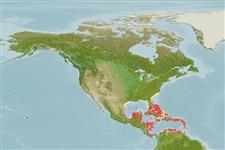Actinopterygii (ray-finned fishes) >
Perciformes (Perch-likes) >
Tripterygiidae (Triplefin blennies) > Tripterygiinae
Etymology: Enneanectes: Greek, ennea = nine times + Greek, nektos = that swimms (Ref. 45335).
Environment / Climate / Range
Ecology
Marine; reef-associated; depth range 0 - 11 m (Ref. 26938). Subtropical, preferred ?; - 9°N
Western Central Atlantic: southeastern Florida in USA, Bahamas and Yucatan in Mexico to Venezuela.
Size / Weight / Age
Maturity: Lm ? range ? - ? cm
Max length : 4.0 cm TL male/unsexed; (Ref. 7251)
Short description
Morphology | Morphometrics
Dorsal
spines
(total): 15;
Dorsal
soft rays
(total): 7;
Anal
spines: 2;
Anal
soft rays: 15. With 5 dark saddle-shaped bars on body; last bar located on caudal peduncle, wider and darker than others. No dark bars on anal fin; iris red (Ref. 26938). Narrow dark bar running ventrally from eye (Ref. 13442).
Adults live in and about coral reefs and rocky shores in clear water. (Ref. 7251). Eggs are hemispherical and covered with numerous sticky threads that anchor them in the algae on the nesting sites (Ref. 240). Larvae are planktonic which occur primarily in shallow, nearshore waters (Ref. 94114).
Life cycle and mating behavior
Maturity | Reproduction | Spawning | Eggs | Fecundity | Larvae
Robins, C.R. and G.C. Ray, 1986. A field guide to Atlantic coast fishes of North America. Houghton Mifflin Company, Boston, U.S.A. 354 p. (Ref. 7251)
IUCN Red List Status (Ref. 115185)
CITES (Ref. 94142)
Not Evaluated
Threat to humans
Harmless
Human uses
Aquarium: commercial
More information
ReferencesAquacultureAquaculture profileStrainsGeneticsAllele frequenciesHeritabilityDiseasesProcessingMass conversion
Tools
Special reports
Download XML
Internet sources
